Protecting Your Children from Dog Bites
As many as 4.5 million people are bitten by dogs every year in the United States, with almost one in five requiring medical attention following the incident. Over 30,000 require reconstructive surgery. The population most at risk is children aged five to nine, especially if they have dogs in their own homes. In fact, the more dogs in the home, the more likely your child is to be bitten, not necessarily by your own dogs, but because your child has no fear of other dogs. So as a parent, how do you protect your children from being bitten?
Teach children to approach dogs with care
If the owner is present, ask for permission before interacting with the dog at all. The dog may not like children, or men, or hats, or whatever, and the owner can give you a heads up before you lose a finger or your child suffers a disfiguring injury. Alternatively, the dog may be working or in training and should not be disturbed. Accept the owner's "no, please don't" with grace, and turn your child away.
Children should learn how to approach all dogs in a non-threatening manner, whether they encounter dogs in your own home or in other people's homes and yards. The child should approach the dog slowly and speak quietly. One hand should be outstretched, with the fingers curled loosely under. The child should allow the dog to sniff his or her knuckles before trying to pet the dog.
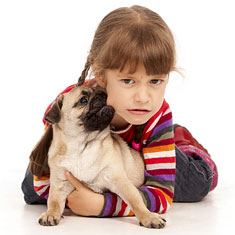
If the dog appears accepting of the child's attention, the child should begin by scratching under the dog's chin, rather than petting the top of the head. Many dogs are head shy and will react negatively to someone reaching to touch the top of the head. If the chin scratching goes well, the child may move around the side of the head to the ears or may begin petting the dog's sides and back. Tummy rubs are most always appreciated, and the dog may lie down and roll over to get one.
As tempting as it is, children should not grab the dog's cheeks and lean in for a kiss. That face-to-face interaction may be too much for the dog, leading to an awful face wound on your child.
Very young children should never be allowed to visit dogs without adult supervision. Both dogs and young children are unpredictable – not a good combination.
Giving a dog treats
If your child has permission to give a dog a treat, teach the child to hold the morsel flat on the palm of the hand, rather than pinching it between fingers to be presented to the dog. Dogs have trouble seeing beyond their noses, and cannot tell the difference between your child's fingers and the treat.
Learn to read the dog's body language
A dog who is afraid is likely to bite. Signs of fear include the tail curling between the hind legs, the whites of the eyes showing, posture low to the ground or leaning backwards, and raised hackles (the fur on the back and neck). The dog may or may not growl or bark as a warning before biting. Read more about behavioral signs of fear.
Dogs to avoid
There are certain times when you never want to disturb a dog. For example, dogs who are confined in a crate, behind a fence, in a car, or tied out tend to be very protective of the space they are occupying. They should never be approached by a child.
Mama dogs who are tending their puppies should be left alone at all times. A mother's instinct is an awesome thing; she will protect her young at all costs. Even if it is your own dog, she will not want to be bothered when she is feeding or grooming her puppies.
You've heard the expression about letting sleeping dogs lie. There is a reason for this, and it's not just because everyone is crabby when they first wake up. When you intrude on a dog's sleep, you may also be intruding on his dreams. If the dream happens to be about catching and eating a squirrel, your hand might be mistaken for the prey. And many of us, dogs included, are disoriented when woken out of a deep sleep. It wouldn't take much for the dog to nip whoever woke him up.
Finally, any dog who is eating should be left entirely alone. Food aggression is very common, particularly in homes with more than one dog. Anyone reaching toward the food dish or bone is fair game for a rebuke that more often than not involves teeth.
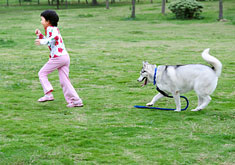
Children as prey
Many dogs have a very strong prey drive as their early ancestors survived by hunting, and their more recent predecessors may have been bred to assist hunters. What attracts a dog to follow prey? The small animal makes a high pitched sound and runs away.
What does your child do when playing or when startled by a dog? He or she may make a high pitched sound and run away. Is it any surprise the dog thinks the child is prey? Not so much. Teach your children never to run from a dog, but to walk away quietly, facing the dog if possible.
What if a dog does attack?
If possible, substitute an object for the dog to bite, rather than hands or legs. If the child is wearing a jacket or carrying a toy or even riding a bike, the object can be "fed" to the dog. What the dog wants is to bite down on something, so he or she may back off to tear apart whatever is in his or her mouth, allowing your child to escape.
If the dog knocks your child down, the child should roll up into a ball, covering his or her ears with curled fists. The parts it will be easiest for the dog to tear off are fingers and ears, so the child should make sure neither are sticking out. Curling into a ball protects the vital organs of the stomach, chest, and neck, leaving only the back and shoulders for the dog to attack. Lying still makes the child seem less like prey. That's not very fun for the dog, who may lose interest quickly.
The child should be trained not to make eye contact with the dog, as this may be interpreted as a challenge. The child can either shut his or her eyes, or simply stare at the ground.
The child should also resist the urge to scream. Again, those high-pitched noises may work the dog into a frenzy because they simulate the noises made by wild prey. Loud yelling in a deeper voice may help to scare the dog away, but high-pitched screams are counter-productive.
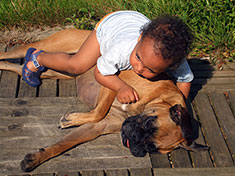
Choosing a dog for your family
To keep your children safe around your own dog, make sure you do your homework before bringing a new dog into your home. Research breeds to find those that are best with children. Experts most often suggest Golden Retrievers, Labrador Retrievers, and Beagles for families with children. See our complete list of dog breeds that are good with kids.
Visit a breeder or shelter and observe how your child reacts to the dogs (both puppies and adults) there. If the child is fearful or mistreats the dogs (pulling tails or poking eyes), perhaps it might be better to postpone adopting a new member of your family.
Using these common sense reminders will help keep both you and your children safe from dog bites. Above all, never assume a dog will be happy to see you. Take the time to assess the dog and to allow the dog to assess you before deciding whether or not further interaction is a good idea.
Doggies Den: Latest Articles
 Homemade Thanksgiving Treats for Your Dog
Homemade Thanksgiving Treats for Your Dog
NUTRITION We all want to include our dogs in our holiday celebrations, but hopefully, you're aware that sharing table scraps with your dog isn't always the best idea.
 Keeping Your Dog Safe during the Summer Months
Keeping Your Dog Safe during the Summer Months
HEALTH Summer is coming on fast, so it’s time to plan how you will keep your dog safe and healthy through the lazy, carefree, warm days.
 Vaccination Time Again-Keeping Your Puppy Healthy
Vaccination Time Again-Keeping Your Puppy Healthy
DOG HEALTH So you have your new puppy picked out. There are quite a few shots, treatments and examinations that will keep the newest member of your family healthy.
 Canine Thanksgiving Feast
Canine Thanksgiving Feast
NUTRITION With the wide variety of food at Thanksgiving dinner, chances are you'll want to give your dog something special, too. If you're contemplating what to feed your dog for the holiday, here is a guide to a great Canine Thanksgiving Feast.
 Dog Walking Tips Every Owner Should Know
Dog Walking Tips Every Owner Should Know
DOG FUN Walking your dog is not only crucial to keeping him healthy and happy, it strengthens the bond between your canine friend and his caregiver. There are a lot of obstacles out there. Don’t forget these simple tips to keep your walk fun and safe in the outside world.
 The Benefits of Physiotherapy for your Dog
The Benefits of Physiotherapy for your Dog
HEALTH The same techniques that physiotherapists use to treat a variety of injuries and conditions in humans have been adapted to suit animals with great success. Family pets, show dogs, and working dogs can all benefit greatly from physiotherapy. Dogs whose activities involve a lot of agility are especially susceptible to the types of problems that physiotherapy can address.
 The Decision- Adding a Dog to Your Family
The Decision- Adding a Dog to Your Family
FIRST TIME OWNERSBringing a dog into your family is a decision where many people don’t realize it’s magnitude until after they have the dog. There are a number of things that you need to research before you decide to purchase a dog, and it starts right in your own home.
 Bringing Your Dog Into Your New Baby's Life
Bringing Your Dog Into Your New Baby's Life
HEALTH Many believe that a dog and a new baby cannot happily coexist, so therefore the dog has to go. This is not necessarily the case.  A new baby does not mean you have to abandon your dog.

Doggies Den:
Most Popular Articles

Dog Pregnancy Symptoms
HEALTHIf you suspect your dog might be pregnant, check out part one in this series on pregnant dogs, where we cover pregnant dog symptoms.
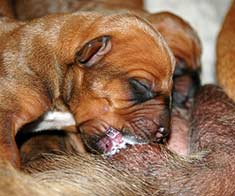
Dog Birth
HEALTHIn the third article of our dog pregnancy series, we look at the wonderful, but messy, process of bringing newborn puppies into the world.

Indoor Dog Potties
DOG PRODUCTSIt's been a long day at work. You were so busy, you didn't even take time to eat a sandwich, let alone run home to let your dog out. You're on your way home, knowing the poor dog is crossing his or her legs by now, when your car breaks down, delaying you even further. Can't somebody make this easier?
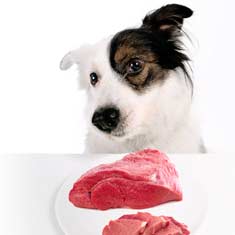
Your Dog’s Digestive System
PHYSIOLOGYEver wonder why your dog eats so fast? Or why he eats gross things? Or why he gets sick to his stomach? Or why his waste stinks so bad? Some of these things are normal, some are not.

Canine Respiratory System
BREATHINGThe basic function of your dog's respiratory system is to bring oxygen in to and remove carbon dioxide from the body. Knowing the symptoms of respiratory diseases can help you help your stay healthy.
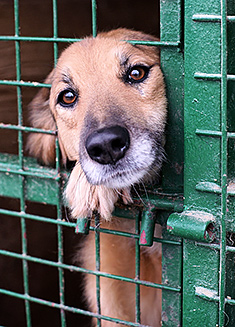
Shelter Dog Adoption Tips for Success
ADOPTION Are you intimidated by the prospect of "rescuing" a dog from a shelter? One reason that you may be wary of adopting a dog from a shelter is not knowing how to choose. Adopting a dog from a shelter can be a rewarding process, if you're prepared to do a reasonable amount of research.

Canine Urinary Tract Infections
SYMPTOMS AND TREATMENTDoes your dog seem to be having trouble relieving his or her bladder? Learn how to recognize the signs of urinary tract infections and how to treat them before they spread.

What to do for Dog Diarrhea
SYMPTOMS AND REMEDIESIf you have dogs in your house for any length of time, you have likely experienced at least one bout of dog diarrhea. Beyond the pain in the tuckus involved in cleaning up the mess, you should know what causes diarrhea, and when it's important to see the vet.
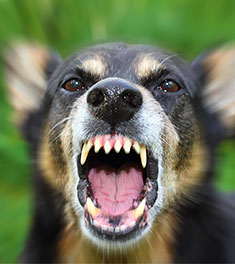
What to do for a Dog Bite
DOG BEHAVIOR Getting bitten by a dog can be scary, and you may be tempted to run around in circles for a while, trying to figure out what to do. Here's our guide to help you manage the situation.

Top Ten Tips for Living with a Senior Dog
DOG HEALTH Bringing home a new puppy is so exciting, but it doesn’t take all that long for your exuberant puppy to grow into a senior dog who may have special needs. Here are the doggies.com top ten tips for taking care of your companion who has been with you through so much.
